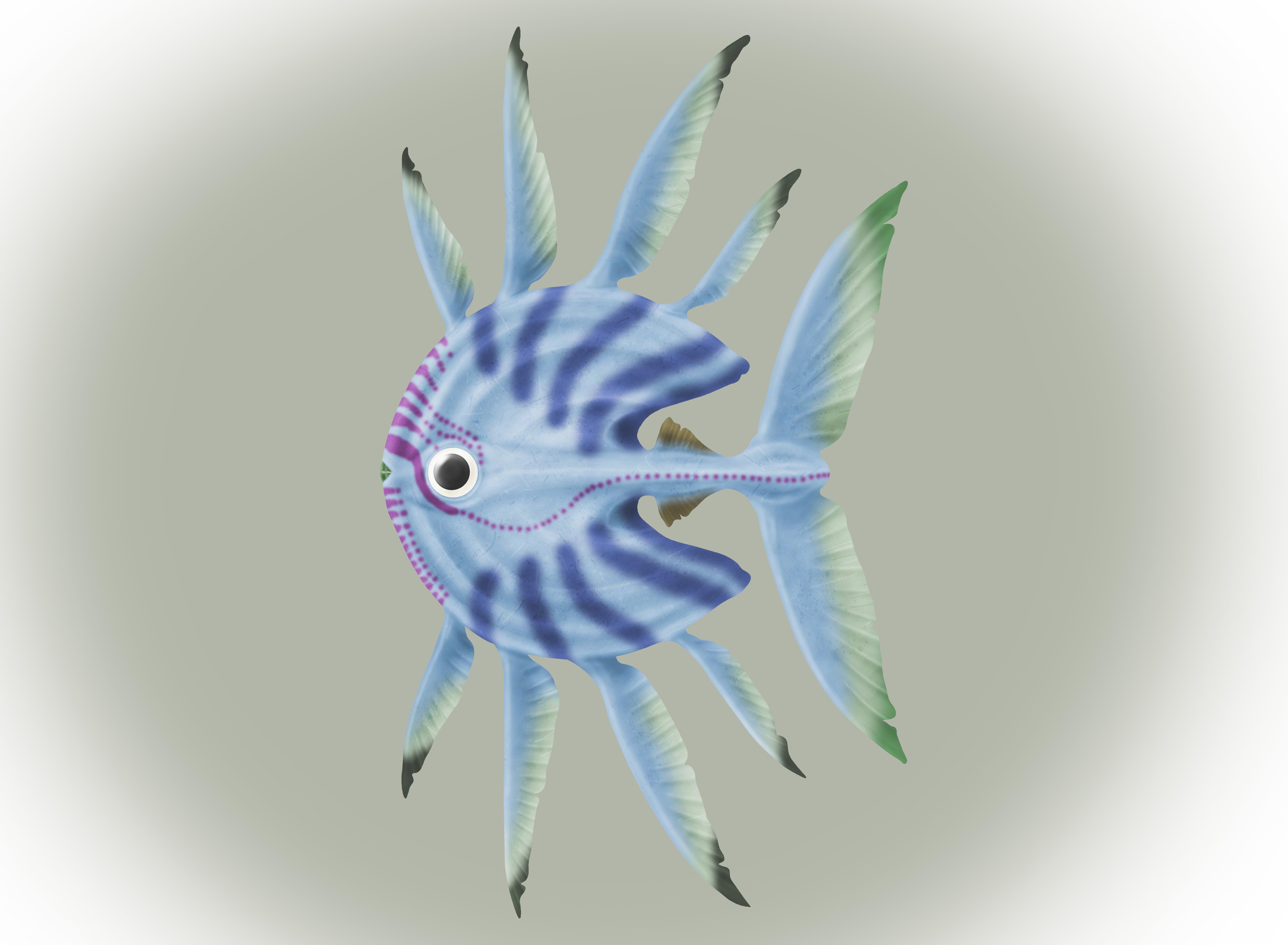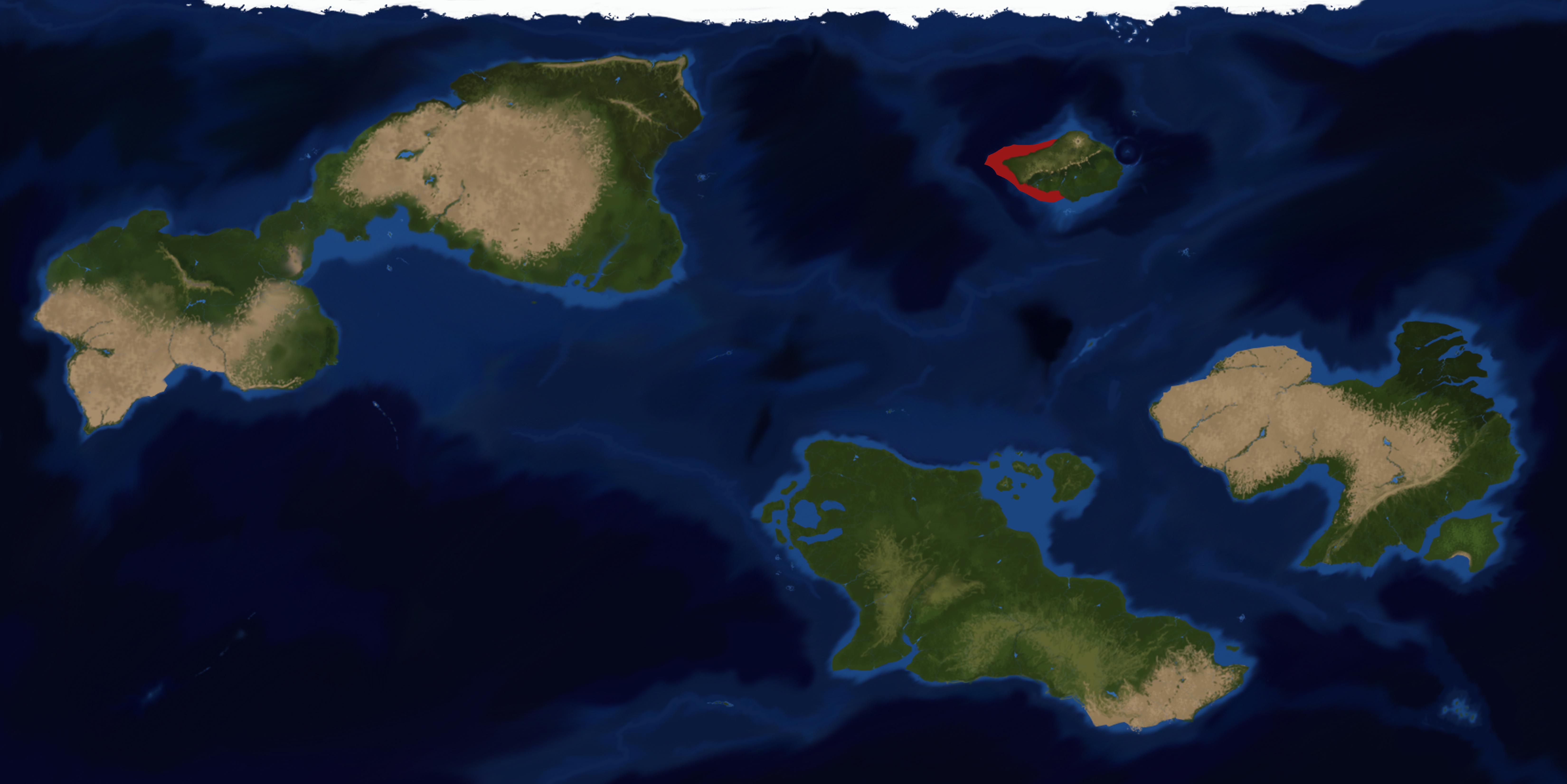Roundbody Bibifish
Bibichthys micrognathus is a species of Cyclopiscopinninid Parahijerakid amphibian from the waters of the Balloon Sea.
The animal, ubiquitous to its native sea, is seen moving in large shoals of several dozen specimens under the canopy of the Balloon Trees, from which they'll try to steer clear of.
The animals communicate constantly with one another through playful chirps and intermittent whistles, signaling emotion and the environment to adjacent conspecific and with the inner section of the group, where the younger specimens are found.
The shoals will often idle in areas they feel protected in, splitting the main colony into smaller spherical groups around areas with plenty of food, where they'll graze on the dead Balloon Trees of the graveyard.
While the animal is mostly herbivorous, it has been observed raiding the nests of Galeocristatoids among their foraging area for extra nutriment.
When threatened, the animal will attempt to avoid predation by actively swimming towards the predatorial trees above, trying to scare the predator from pursuing them where they both could fall prey to the plant.
If idling, the species will prefer to find shelter in the graveyard along the seafloor and regroup among the carcasses of the Balloon Trees before running towards the surface in their usual defensive tactic.
B. micrognathus is often hunted by animals such as the Yellowback Ploughead and the Kryptoarthrocephalus sp. but will sometimes fall victim to Mime Cockatielfishes mistaking it for the harmless Cockatielfish.
The animal has seen several usages in human cultures both locally and globally over the years:
- It's farmed for human consumption along the western coasts of Gleann Blathànna and in the reclaimed areas of the forests
- It's farmed and sold as a pet globally for its cute appearance and friendly disposition
- Wild shoals of the open prairies attract tourism due to their curiosity and willingness to accept food and play with divers
Basic Information
Anatomy
- Rounded head and body.
- Mouth very small, eye round and large.
- Body symmetrical and very thin.
- Four Dorsal fins along the back of the half-moon, the ventral section is composed by the single pectoral and the first three anal fins, all spear shaped and thin.
- Along the Gill Tail grow Dorsal V and Anal IV.
- Gill Tail very thin and partially covered by the Half-Moon.
- Gill Fan small compared to the body, ending in two large symmetrical Caudal Fins
Genetics and Reproduction
Mandatorily monogamous species.
B. micrognathus mates in the spring.
Couples among the large shoals are already formed and fixed, meaning that the specimens will choose one single mate for the entirety of their life, usually during the first year of life.
Members of the couple will mate several times during a single day, taking pauses between one intercourse and the next with long grooming sessions, various displays such as dances and cheerful chirping, and couple foraging.
The eggs are incubated inside the duct for seven to ten days before deposition in small protected areas among the sandy terrain under the graveyard.
The eggs hatch eight days later, the hatchlings will instinctively swim towards the shoal outside the graveyard, where they'll start their journey to the center of the forests where the shoals will unite and exchange the young.
Growth Rate & Stages
Ontogenesis very visible.
Young specimens are born transparent to be less visible, the fins will be shorter and rounder.
Loss of natal aculeus minutes after birth.
Once a couple in the species is formed, it will never break up, if one member of the couple dies the other won't reproduce again.
Ecology and Habitats
Epipelagic species found at depths ranging from 10 to 60 m.
The animal lives in the open waters under the canopy of the Balloon Forests and along the open seagrass prairies.
Dietary Needs and Habits
Herbivorous species that uses the small beak to nibble at the plants laying on the seafloor, sometimes raids nests for eggs.
Biological Cycle
Seasonal creature mostly active from Spring to late autumn, finding shelter in repaired areas during the winter.
Additional Information
Social Structure
Very social animal that lives in large layered shoals.
The outside layer is composed by the elderly and the single specimens, which will protect the deeper layers from risk; the middle layer's composed by the coupled specimens while the innermost one contains the young and immature, which are the most protected.
As soon as the young are born, the shoals will migrate in the inner forests where the various schools will exchange offspring.
The animals will communicate between members of the same group with cheerful chirps and will partake in daily grooming activities while idling.
Domestication
Popular aquarium pet worldwide due to the canonically cute appearance and friendly behavior towards people.
Sold in pre-established couples, the specie is beginner friendly and will accept any kind of algae paste and small leaves.
It is recommended to give them rocks covered in algae regularly to both stimulate them to feed by themselves and to keep the beak from overgrowing.
Available in a limited array of morphs such as Warpaint and Fluo Fin.
Uses, Products & Exploitation
Serves different human uses both as food and as a popular pet.
The Species is becoming invasive in algae farming due to the several extermination campains reducing predator populations.
Geographic Origin and Distribution
Perception and Sensory Capabilities
Very good eyesight and hearing.
Symbiotic and Parasitic organisms
Afflicted by skin parasites they remove through intraspecific grooming.
Sometimes parasitized by ocular worms.
Scientific Name
Eoichthyia; Hijerakia; Parahijerakida; Cyclopiscopinninoidea ; Cyclopiscopinninidae; Bibichthys; B. micrognathus
Lifespan
6 Years
Conservation Status
Least Concern: No measures underway to protect the species.
Population Trend: INCREASE
Average Weight
60 gr to 1 kg
Body Tint, Colouring and Marking
Azure to light blue body, green beak.
Purple striping along the cranial section of the body, blue striping along the remaining half-moon.
Medial purple line runs over the length of the body.
Dorsal fins up to IV, pectoral and anal fins up to III beige tipped with dark grey to black proximal ends.
Dorsal V & Anal IV brown.
Caudal fins bordered in beige with green tips.
Remove these ads. Join the Worldbuilders Guild












Comments